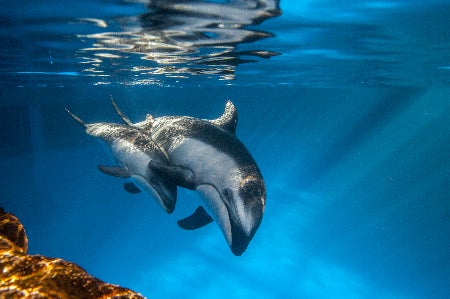Spring is thought of as the season of new life. It’s true, many babies are born in the spring due to the good weather and plentiful food. In general, conditions are good for growth. But not all babies are born in the spring—in fact, we have babies born at the aquarium during all times of the year, and this is the case in the wild too. There are numerous biological strategies around reproduction and the rearing of offspring in the animal world and this is a fascinating and important area of study.
Reproduction can be thought of as one of the [and some may suggest the primary] defining characteristics of life. There is no doubt that passing genetics along to next generations is biologically critical. While some animals lay eggs, others give live birth, and some provide care to their offspring, while others leave them to their own devices and so on. With Mother’s Day approaching on May 14, it is interesting to see how we’ve witnessed a variety of maternal behaviors in the animal kingdom.
At Shedd Aquarium, pink skunk clownfish share an interesting co-parenting strategy. The female will lay her eggs in the protective anemone, stinging tentacles that guard against predators, while the male cares for them. If he has to travel too far for food, he will skip eating to stay nearby and care for them. However, if the male is not doing enough for the offspring, the female will chase him away and find a new mate. She oversees the male during the parenting process.
We’ve also seen throughout the years a female beluga become the “auntie” of the group and provide alloparenting to young calves. While not the mother, Naya nurtures nearly every calf born at Shedd. With her gentle, playful nature, she is the first beluga introduced to the calves, besides their mother, as part of their socialization. Naya provides companionship by swimming with the little ones to allow the mothers time to rest, and she even helps nurse the calves, which is a phenomenon called ‘spontaneous lactation’ and is not uncommon in whales and dolphins when they spend time around calves for three to seven days.
Witnessing a first-time mother is always a special moment. Staff watched Katrl, the newest Pacific white-sided dolphin mother, give birth to her first calf on April 18, 2016. Everything went ‘swimmingly’ as the new calf, Kukdlaa, reached his first milestones like taking his first breath, bonding with mom, nursing and more. Mother and son are often still spotted swimming together one year later!

California sea lions have a well-known maternal strategy. All California sea lion pups are born right around June 15. They spend a lot more time being attended to and cared for by mom. They nurse for about nine or ten months and then get weaned to fend for themselves. During this extended time, moms range around the islands to catch fish, while the pups stay ashore waiting in what are called rookeries. With full bellies moms come back, find their babies amid the crowds of hungry pups [that look almost identical] and settle in to nurse them.
Here at the aquarium we recently experienced an example of one of the most unusual maternal strategies there is. Surinam toads (Pipa pipa) are an aquatic toad. The adults look a lot like leaves and spend most of their time sprawled out in the water not moving a muscle. Pipa mothers go to extreme lengths to protect their developing eggs; they embed them in the skin of their own backs until they hatch as fully formed baby toads. The specialized skin on the back of the female thickens and the fertile eggs bury into the mom and her skin grows over them. Our staff was thrilled to witness this natural wonder occur in our very own aquarium this spring! Because the process is so rare, our aquarists worked to re-create conditions to stimulate this to happen. Water levels were changed, artificial rain was created, and so on. It is important to understand what these conditions are so we can ensure we are not impacting them in native populations in the wild. The detailed observations we are able to make in the controlled setting of the aquarium are vitally important to improving our understanding of the influence of change in the environment on resident animal reproduction.